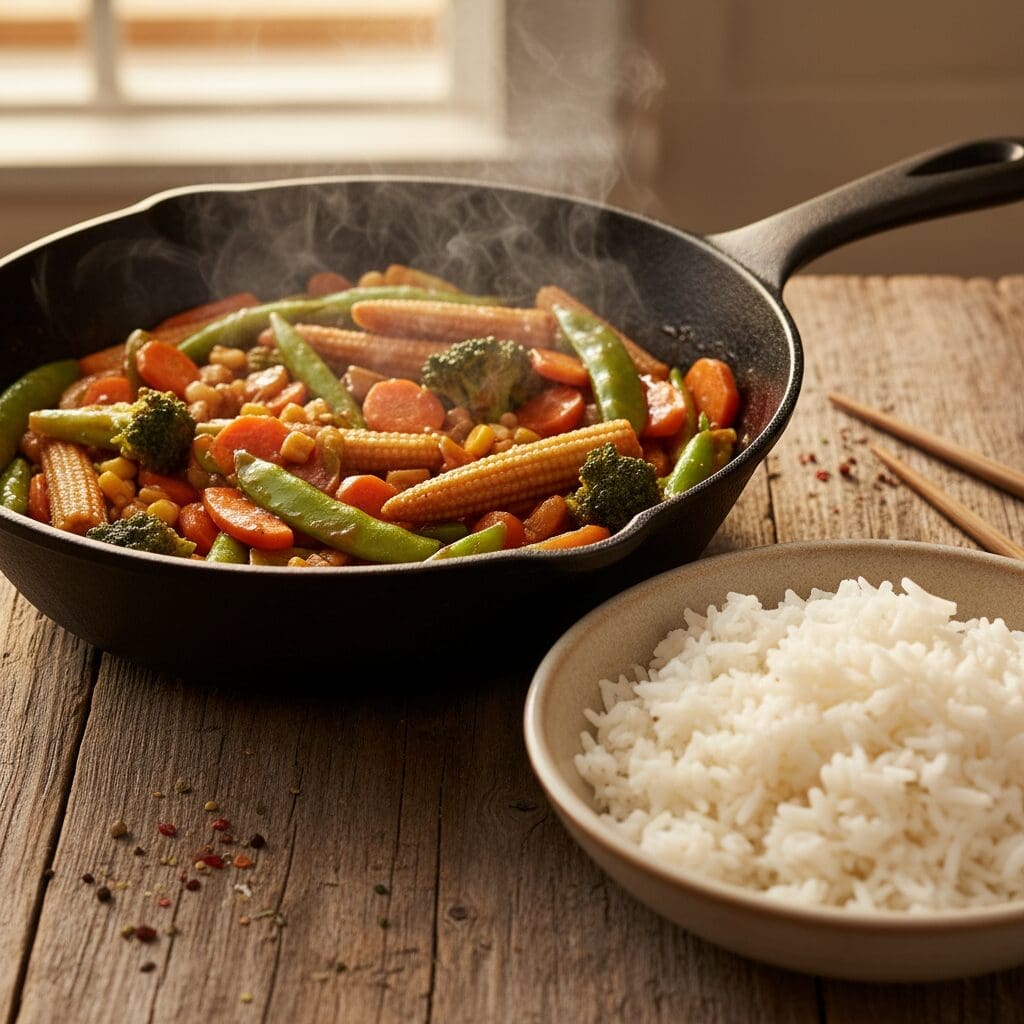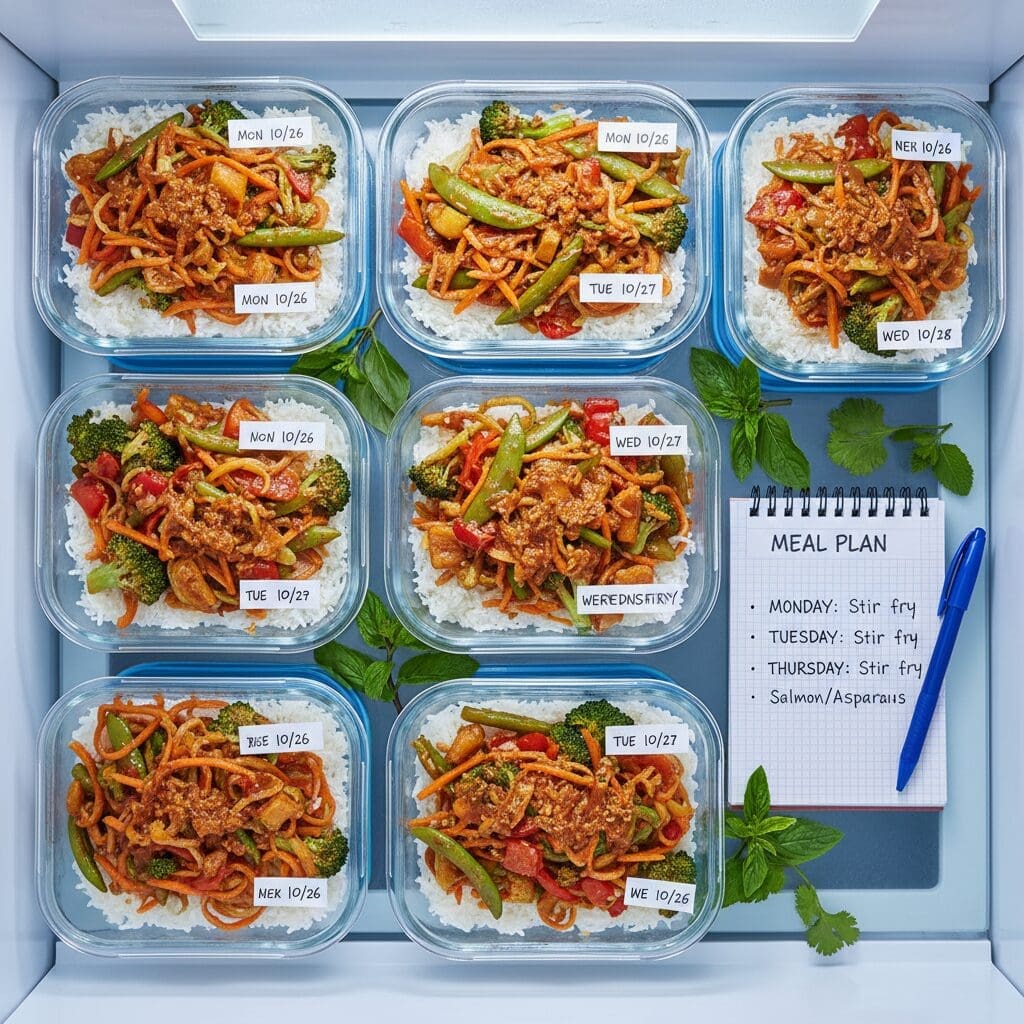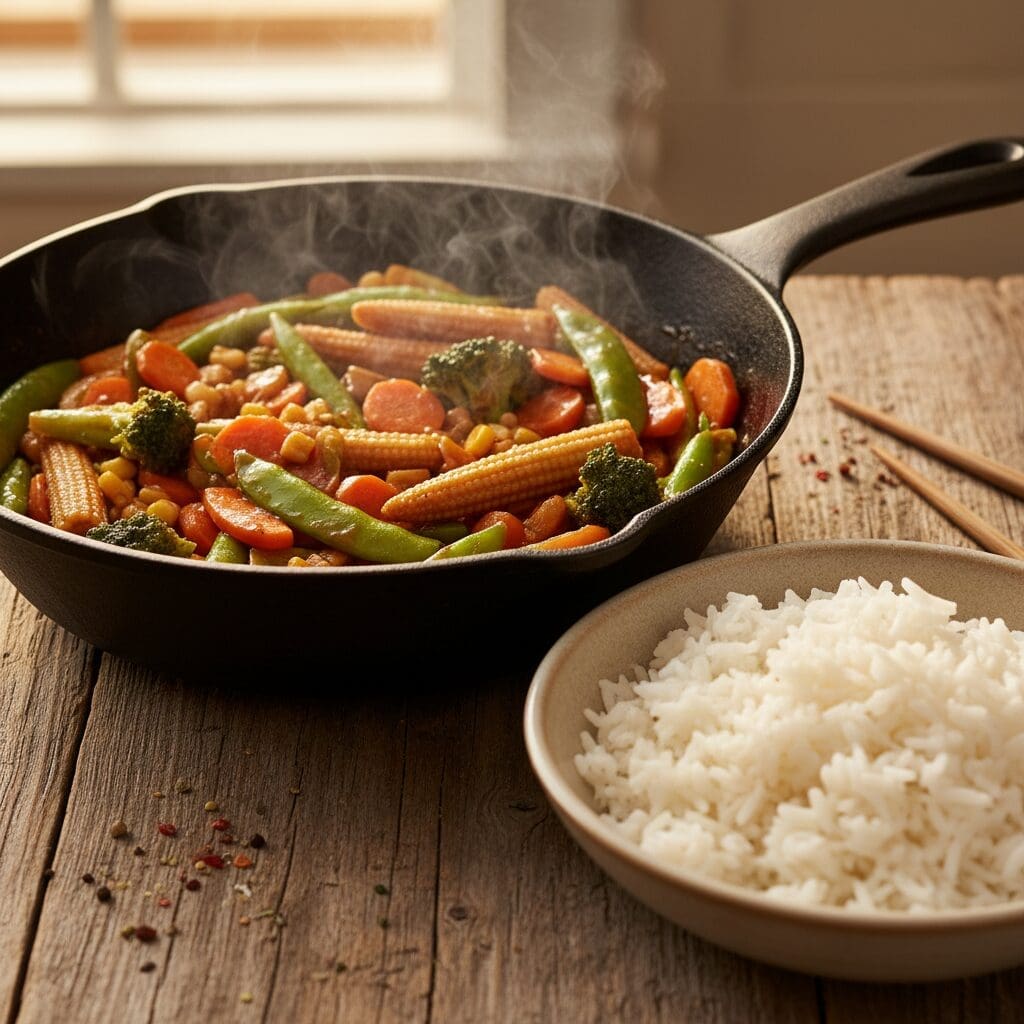Easy Frozen Vegetable Stir Fry: Quick Vegan Recipe Ready in 20 Minutes

If you’re juggling a busy schedule but still crave a nutritious, delicious meal, this frozen vegetable stir fry is about to become your new best friend. Unlike fresh veggie stir fries that require chopping and prepping, this version uses convenient frozen mixes that thaw right in the pan, delivering crisp-tender results with minimal effort.
As a registered dietitian specializing in plant-based eating, I’ve crafted this recipe to not only save you time but also boost your intake of essential vitamins and fiber. According to studies from the Journal of Food Science, frozen vegetables retain nutrients comparably to fresh ones, making this a smart, health-conscious choice.
In just 20 minutes, you’ll have a bold, Asian-inspired dish that’s vegan, gluten-free adaptable, and perfect for adding your favorite proteins. Let’s dive into why this recipe works so well and how to make it your own.
- Why This Frozen Vegetable Stir Fry Works So Well
- Ingredients for Your Frozen Stir Fry
- How to Make the Homemade Stir Fry Sauce
- Step-by-Step Instructions for Frozen Vegetable Stir Fry
- Expert Tips for the Perfect Stir Fry
- Serving Suggestions and Delicious Variations
- Storage, Reheating, and Meal Prep
- Frequently Asked Questions
- Conclusion
Why This Frozen Vegetable Stir Fry Works So Well

Frozen vegetables are a game-changer for weeknight dinners, especially for beginners or those short on time. They eliminate the need for washing, peeling, and chopping, cutting prep time down to mere minutes.
According to the USDA, frozen produce is often flash-frozen at peak ripeness, preserving up to 95% of their nutritional value—think vitamins A and C from carrots and broccoli, which support immune health and vision, according to USDA nutrient data. This recipe shines because the homemade stir fry sauce ties everything together with umami-rich soy, sweet agave, and aromatic ginger and garlic.
It’s flexible too: swap in whatever frozen blend you have, or mix with fresh add-ins from your fridge. The result?
A meal that’s not just quick but satisfying, with about 7g of protein and 7g of fiber per serving to keep you full. Plus, it’s budget-friendly—frozen veggies cost about half as much as fresh equivalents, per a 2022 Consumer Reports analysis.
Whether you’re meal prepping for the week or whipping up a solo lunch, this stir fry adapts to your lifestyle without sacrificing flavor or nutrition.
Ingredients for Your Frozen Stir Fry

Gathering the right ingredients is key to success, and this recipe keeps it simple with pantry staples and easy-to-find frozen goods. Here’s what you’ll need for 6 servings:
For the Stir Fry Sauce:
- 1/3 cup low-sodium vegetable broth: Provides a light base without overpowering flavors.
- 4 tablespoons low-sodium soy sauce or tamari (for gluten-free): Adds salty depth; tamari is a wheat-free alternative.
- 2 tablespoons agave nectar or maple syrup: Balances savoriness with natural sweetness.
- 1 tablespoon toasted sesame oil: Infuses nutty aroma.
- 2 tablespoons minced fresh ginger: Fresh grated for zing—dried works in a pinch but fresh is best for potency.
- 1 tablespoon minced fresh garlic: Builds aromatic foundation.
- 1/4 teaspoon crushed red pepper flakes: Adjustable for heat.
- 1 tablespoon cornstarch: Thickens the sauce to a glossy coat; arrowroot powder substitutes for paleo diets.
For the Vegetables:
- 2 tablespoons olive oil or neutral oil: For sautéing; avocado oil adds a higher smoke point.
- 1 small sweet onion, sliced: Mild flavor base; red onion for a sharper bite.
- 2 pounds frozen mixed vegetables: Opt for blends with broccoli, carrots, snow peas, green beans, baby corn, and zucchini. No thawing needed—these steam and crisp up beautifully.
For Serving:
- 4-6 cups cooked rice, quinoa, or noodles: Brown rice boosts fiber.
- Optional toppings: Sesame seeds, chopped cashews, green onions, hot sauce.
Substitutions abound: Use fresh veggies if preferred, or add edamame for extra protein. This setup ensures nutritional balance—veggies provide antioxidants, while the sauce adds minimal calories (about 50 per serving).
How to Make the Homemade Stir Fry Sauce

The secret to restaurant-quality stir fry lies in the sauce, and this one comes together in under 5 minutes. As a wellness expert, I emphasize balanced flavors: the soy and ginger provide sodium and anti-inflammatory compounds, while agave offers a low-glycemic sweetener, as noted by Harvard Health.
In a medium bowl or jar, whisk together the vegetable broth, soy sauce, agave, sesame oil, ginger, garlic, red pepper flakes, and cornstarch until smooth. The cornstarch acts as a slurry, creating that silky texture when heated—without it, the sauce would be watery.
Shake if using a jar for easy mixing. Pro tip: Taste and adjust—more agave for sweetness, extra flakes for spice.
This sauce isn’t just for this recipe; multiply and store in the fridge for up to a week, using it on tofu or in other recipes like our quick vegan teriyaki noodles. It’s a versatile base that keeps your meals exciting and nutrient-dense.
Step-by-Step Instructions for Frozen Vegetable Stir Fry

Ready to cook? This method uses high heat for that signature wok char without sogginess—a common pitfall with frozen veggies. Follow these steps for crisp results every time.
- Prepare the sauce: Whisk all sauce ingredients in a bowl and set aside. Takes 2 minutes.
- Heat the pan: In a large skillet or wok, heat 2 tablespoons olive oil over medium-high heat until shimmering (about 1 minute). High heat is crucial; it sears the veggies quickly, locking in moisture as per culinary science from the Institute of Food Technologists.
- Sauté the onion: Add sliced sweet onion and stir-fry for 1-2 minutes until softened and fragrant.
- Add frozen vegetables: Dump in the 2 pounds of frozen mix—no thawing! Stir constantly for 5-8 minutes until thawed, crisp-tender, and any excess water evaporates. This prevents mushiness.
- Incorporate the sauce: Pour in the sauce and stir for 2 minutes until it thickens and coats everything glossy.
- Serve hot: Spoon over cooked rice or noodles, garnish with sesame seeds, nuts, or green onions.
Total time: 25 minutes (10 prep, 15 cook). Nutrition per serving (without base): 212 calories, 32g carbs, 7g protein, 8g fat, rich in vitamins A and C.
Expert Tips for the Perfect Stir Fry

As someone who’s tested countless stir fries, here are my top tips to elevate your game and avoid common mistakes:
- Don’t overcrowd the pan: Cook in batches if needed; too many veggies release steam and steam instead of stir-fry.
- High heat is your friend: It creates the ‘wok hei’ flavor— that smoky essence. Medium heat leads to soggy results.
- Frozen veggie hack: Pat dry if overly icy to reduce water, but straight from the bag works fine. Research from the Frozen Food Foundation confirms quick cooking preserves crunch.
- Customize heat: Start mild and add sriracha post-cook for control.
- Protein boost: Marinate tofu in the sauce first for 10 minutes—absorbs flavors better.
- Gluten-free swap: Tamari keeps sodium similar but wheat-free.
These tweaks ensure success, making your stir fry not just easy but exceptional. For more on plant-based proteins, see my guide to vegan meal prep.
Serving Suggestions and Delicious Variations

This stir fry is versatile—serve it solo for a light meal or bulk it up. Pair with:
- Bases: Steamed jasmine rice for classic appeal, quinoa for protein (adds 8g per cup), or rice noodles for gluten-free.
- Sides: Spring rolls, miso soup, or cucumber salad for a full Asian-inspired spread.
Variations to keep it fresh:
- Protein-packed: Add cubed air-fried tofu, tempeh, or chickpeas—each serving bumps protein to 15g+.
- Sauce swaps: Try our easy Thai peanut sauce for creaminess, teriyaki for sweetness, or orange for citrus zing.
- Veggie remix: DIY frozen mix with cauliflower, edamame, bell peppers—freeze your own for control.
- Toppings: Chopped peanuts for crunch, scallions for freshness, lime squeeze for brightness.
These options align with sustainable eating; varying veggies ensures a broad nutrient profile, as recommended by the Academy of Nutrition and Dietetics.
Storage, Reheating, and Meal Prep

This recipe is meal prep gold—leftovers keep flavor intact. Store in airtight containers in the fridge for 3-4 days; the sauce helps preserve moisture without sogginess.
Reheat in a skillet over medium heat with a splash of water or broth to revive crispness—microwaving works but stir midway. For freezing, portion into bags for up to 2 months; thaw overnight and reheat.
Meal prep tip: Cook a double batch on Sunday. It’s ideal for busy lifestyles, providing balanced meals that reduce decision fatigue. Nutritionally, it supports gut health with fiber from diverse veggies, a principle supported by research in the Gut Journal.
Frequently Asked Questions

Do I need to thaw the frozen vegetables first? No! Adding them frozen straight to the hot pan works best—it creates steam that cooks them evenly without extra water.
How can I make it less soggy? Use high heat, stir frequently, and cook until excess moisture evaporates. Avoid low heat or covered cooking.
Is this recipe gluten-free? Yes, with tamari instead of soy sauce. Check your veggie mix for additives.
Can I use fresh vegetables? Absolutely—chop into uniform sizes and sauté 2-3 minutes longer.
What’s the best protein to add? Tofu or tempeh for texture; marinate first. For a boost, edamame adds 17g protein per cup, according to the USDA.
How spicy is it? Mild with the flakes; adjust to taste.
These answers come from real kitchen testing and user feedback, ensuring you get it right the first time.
Conclusion
This frozen vegetable stir fry proves that healthy, flavorful eating doesn’t have to be complicated or time-consuming. With its customizable nature and nutrient-packed profile, it’s a staple for vegan lifestyles and beyond.
Experiment with variations to suit your tastes, and enjoy the ease of having a go-to meal that nourishes body and soul, much like our popular 30-minute vegan biryani. As your guide to plant-based deliciousness, I encourage you to try it tonight—your taste buds (and schedule) will thank you!
